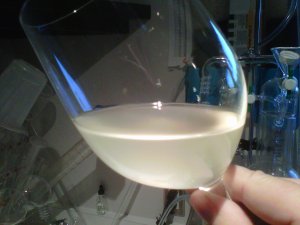Receiving barrels
September 6, 2012
Today we received twenty-five brand new oak barrels from the cooperage Seguin Moreau!

Seguin Moreau barrels are very well suited to powerful reds like Cabernet Sauvignon and Zinfandel, they impart a wealth of oak related characters, such as coffee and spice, without ever tasting directly of wood (a character that is sometimes known as ‘planky’).
Richard has worked with barrels from Seguin Moreau for many years, they are consistently well-made and deliver the characters that suit our wines, and so we rely almost entirely on them for ageing both our Zinfandel and Cabernet Sauvignon.

Twenty of the new barrels are made of French oak, and five are made of American oak. French oak generally delivers a more subtle flavor profile and tannin structure than American oak, and so it makes up the bulk of our barrel selection. The American oak is used as an accent, providing an intense note of toastiness and vanilla.
Walking through the estate vineyards and tasting the grapes in the last few days is revealing an excellent potential for the 2012 vintage, the flavors are extremely concentrated and the color is intense, even several weeks before they are ready to harvest. Be sure to check back with us here on the blog to see how it’s going!

Amapola Creek is Richard Arrowoods’ latest winemaking project, to visit the Amapola Creek Winery main site, please click here.
The first pick is scheduled!
September 5, 2012
Today we went out and sampled the Chardonnay at the Belli ranch again. Block 3 (Rued clone, which is a slightly Musque, or Muscat, selection of Chardonnay) is always the first block to come in, so it’s the one we took the closest look at today. We asked Joe to turn down the irrigation last week, to let the flavor of the berries gain in concentration.

Once we start getting closer to the moment of harvest, we switch over from berry sampling to cluster sampling. Cluster sampling uses a much larger volume of fruit, and is therefore generally more accurate than berry sampling. Since this kind of testing is more accurate, it allows us to more finely tune our choice of harvest date.
The decreased irrigation coupled with the gorgeous weather we’ve been having gave us the result we were hoping for, the berries are tasting just at the edge of being ripe, and so we will begin harvest 2012 this Friday!
Now that we have a firm start date, we are beginning the last few preparations that we need to make. Since we will need the press on the day we receive the Chardonnay, today we got it set up and cleaned it inside and out.

The outside of the press has some dust on it, even though it’s been covered since last year.
This is also our chance to make sure that the press is operating the way it’s supposed to. Once the grapes are here we will need to process them as quickly as possible, so if there’s anything wrong with the press we need to know about it ahead of time.

The inside of the press needs to be as clean as possible, so we rinse it thoroughly with a solution of sodium percarbonate, which kills any microorganisms which may have carried over from last year. To make sure the coverage is thorough, we let the solution collect in the juice tray and then pump it up into the press itself, repeating the process several times.
Everything is looking pretty good, the equipment is clean, it works, and some unbelievably delicious grapes are on the way. We’re really looking forward to this harvest, please follow it with us here on the blog!
Amapola Creek is Richard Arrowoods’ latest winemaking project, to visit the Amapola Creek Winery main site, please click here.
Topping
July 11, 2012

While most of our efforts are focused on the vineyard right now, there is still some work to be done inside the winery. This week, we are topping again.

Our barrels are stacked high enough that they cannot all be topped from the ground. To reach the barrels at the top, we use this rolling staircase. The alternative is to either use a ladder (dangerous) or to unstack the barrels (time consuming). The staircase is ideal in trms of safety and convenience.
Getting up to the level of the highest barrels is only part of the problem. Since these barrels are so much higher, it takes a lot more pressure to push the wine up to them. The person doing the topping has to constantly adjust the gas pressure being applied to the topping wine, making sure it is high enough to reach the upper barrels, but not so high that it sprays wine everywhere. 























